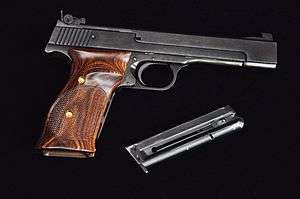Smith & Wesson Model 41
| Smith & Wesson Model 41 | |
|---|---|
 Smith & Wesson Model 41 | |
| Type | Semi Automatic Pistol |
| Place of origin |
|
| Specifications | |
| Weight | 41 oz |
| Length | 10 1⁄2" |
| Barrel length | 5 1⁄2" or 7" |
|
| |
| Cartridge | .22 long rifle |
| Action | blowback, single action only |
| Rate of fire | Semi-automatic |
| Feed system | 10-round single column, detachable box magazine |
The Smith & Wesson Model 41 is a semi-automatic pistol developed by Smith & Wesson after World War II as a competitive target pistol. It was designed with a 105 degree grip angle, the same as the Colt M1911 pistol, to maintain a consistent grip angle.[1]
Production history
In July 1947 two prototypes, numbered X-41 and X-42 were produced, tested, and improved for the next 10 years. In 1957 the Model 41 was made available to the public for sale when S&W produced 679 units.[2] At the end of 1958, they had built 9,875 Model 41 pistols. A lighter 5" barrel was offered in 1958 for field use. The Model 41-1 was introduced in 1960 and was chambered in .22 Short for International Rapid Fire competition. Only 1000 were made using light aluminum slides necessary for function with the lower powered .22 Short.
In August 1963, the 5" heavy barrel version came into the market. Stoeger's Shooter's Bible of 1964 shows a 7 3/8" barrel grooved for Olympic center weights. The cocking indicator and 7 3/8" bbl were dropped in 1978. The 7" bbl was introduced in 1978 with no provision for a muzzle brake. A 6" barrel was offered for a few months in 1991. In 1992 the Model 41 was dropped from production. In 1994 Smith & Wesson returned it to production as the Model 41 (New Model).[3]
Model 46
In 1957, Smith & Wesson offered a "no frills" version of the Model 41 designated the model 46. In 1959 it was selected by the U.S. Air Force for basic marksmanship training. About 4000 units were made in total: 2500 with a 7-inch barrel, 1000 with 5 inch barrels and 500 5 1/2 inch barrels. The pistol lacked the checkering, polished blue finish, and other refinements of the Model 41. It proved to be a commercial failure with consumers who preferred the more costly Model 41 and production ceased in 1966, according to firearm historian Sam Fadala.[4]
References
- ↑ Hartink, A.E. (2002). The Complete Encyclopedia of Pistols and Revolvers. Edison, New Jersey: Chartwell Books, Inc. pp. 271–272. ISBN 978-0-7858-1519-8.
- ↑ Jinks, Roy G.; Krein, Sandra C. (2006). Smith & Wesson (MA) (Images of America). Boston: Arcadia Publishing. p. 128. ISBN 978-0-7385-4510-3.
- ↑ Supica, Jim; Richard Nahas (2007). Standard Catalog of Smith & Wesson (3 ed.). F+W Media, Inc. p. 279. ISBN 978-0-89689-293-4.
- ↑ Fadala, Sam (2002). "Smith & Wesson's Model 41: collectibles, edibles, and a lesson in history". American Handgunner. 22 (6): 83.
